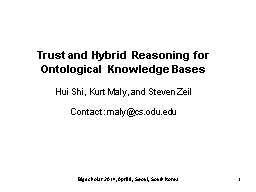PPT-Kelly Flanagan April 20, 2014
Author : sherrill-nordquist | Published Date : 2018-03-19
Mexico City Predicting the Next Big Earthquake Motivation Why study earthquakes in Mexico City Mexico City is uniquely susceptible to highly damaging earthquakes
Presentation Embed Code
Download Presentation
Download Presentation The PPT/PDF document "Kelly Flanagan April 20, 2014" is the property of its rightful owner. Permission is granted to download and print the materials on this website for personal, non-commercial use only, and to display it on your personal computer provided you do not modify the materials and that you retain all copyright notices contained in the materials. By downloading content from our website, you accept the terms of this agreement.
Kelly Flanagan April 20, 2014: Transcript
Download Rules Of Document
"Kelly Flanagan April 20, 2014"The content belongs to its owner. You may download and print it for personal use, without modification, and keep all copyright notices. By downloading, you agree to these terms.
Related Documents














